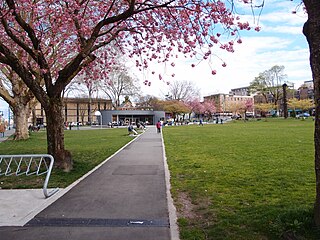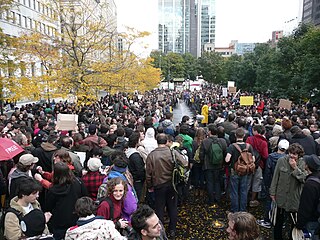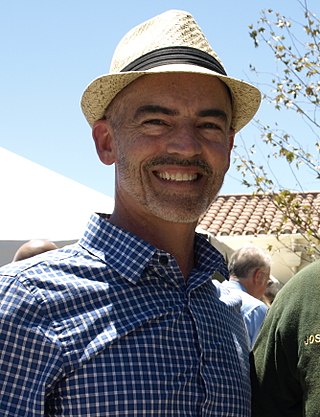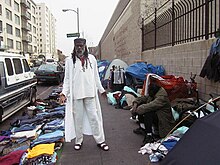
A skid row, also called skid road, is an impoverished area, typically urban, in English-speaking North America whose inhabitants are mostly poor people "on the skids". This specifically refers to people who are poor or homeless, considered disreputable, downtrodden or forgotten by society. A skid row may be anything from an impoverished urban district to a red-light district to a gathering area for people experiencing homelessness or drug addiction. In general, skid row areas are inhabited or frequented by impoverished individuals and also people who are addicted to drugs. Urban areas considered skid rows are marked by high vagrancy, dilapidated buildings, and drug dens, as well as other features of urban blight. Used figuratively, the phrase may indicate the state of a poor person's life.

The Chinatown–International District of Seattle, Washington is the center of the city's Asian American community. Within the district are the three neighborhoods known as Chinatown, Japantown and Little Saigon, named for the concentration of businesses owned by people of Chinese, Japanese and Vietnamese descent, respectively. The geographic area also once included Manilatown.

A Hooverville was a shanty town built during the Great Depression by the homeless in the United States. They were named after Herbert Hoover, who was President of the United States during the onset of the Depression and was widely blamed for it. The term was coined by Charles Michelson. There were hundreds of Hoovervilles across the country during the 1930s.

Dignity Village is a city-recognized legal encampment of an estimated 60 homeless people in Portland, Oregon, United States. In the days before Christmas of 2000, a group of individuals living outdoors in Portland established a tent city. It evolved from a group of self-described "outsiders" squatting a city owned land to a self-regulating, city-recognized campground as defined by Portland city code. The encampment is located on land near Portland International Airport, and has elected community officials and constructed crude but functional cooking, social, electric, and sanitary facilities.
Tent City 4 is a homeless encampment of up to 100 persons operated by homeless residents and sponsored by 501(c)(3) organizations Seattle Housing and Resources Effort (SHARE) and Women's Housing Equality and Enhancement League (WHEEL). The camp was created in May 2004 and limits itself to places of worship in eastern King County outside of Seattle. Minors are not allowed in Tent City 4, although there is a provision for emergency situations. Residents may use their own tents or community tents that are segregated by gender. Dumpsters, portable toilets and a shower, paid for by SHARE, are provided to address sanitation concerns. In order to control access to the encampment, there is only one entry/exit to the camp that is guarded at all times.

Oppenheimer Park is a park located in the historic Japantown (Paueru-Gai) in the Downtown Eastside, Vancouver, British Columbia, Canada.

In the Seattle King County area, there were estimated to be 11,751 homeless people living on the streets or in shelters. On January 24, 2020, the count of unsheltered homeless individuals was 5,578. The number of individuals without homes in emergency shelters was 4,085 and the number of homeless individuals in transitional housing was 2,088, for a total count of 11,751 unsheltered people.

The Jungle, officially known as the East Duwamish Greenbelt, is a greenbelt on the western slope of Beacon Hill in Seattle, Washington that is known for its homeless encampments and crime. The Jungle consists of 150 acres (61 ha) underneath and along an elevated section of Interstate 5 between South Dearborn Street and South Lucile Street. An assessment counted 201 tents and estimate of more than 400 people in the area prior to a shooting on January 26, 2016, that increased scrutiny and a sweep of the greenspace. The area continues to be used by the homeless as of 2023.

Occupy Canada was a collective of peaceful protests and demonstrations that were part of the larger Occupy Together movement which first manifested in the financial district of New York City with Occupy Wall Street, and subsequently spread to over 900 cities around the world.

The Occupy movement began in the United States initially with the Occupy Wall Street protests in New York City, but spread to many other cities, both in the United States and worldwide. This list article is an alphabetical, non-chronological summary of Occupy events that have occurred in cities in the United States.
Occupy Windsor was an Occupy movement encampment in David Croll Park, Windsor, Ontario, Canada. The protest ended and all protesters evacuated the area on December 12, 2011 with promises to return to the park to reseed areas damaged by the camp.

Mitch O'Farrell is an American politician, who served as a member of the Los Angeles City Council for the 13th district from 2013 to 2022, during which he spent eight days as President of the City Council during the 2022 Los Angeles City Council scandal. A member of the Democratic Party, O'Farrell was the first Native American elected to the body, and was one of its two openly gay members until the end of his second term in 2022.

The San Francisco Bay Area comprises nine northern California counties and contains four of the ten most expensive counties in the United States. Strong economic growth has created hundreds of thousands of new jobs, but coupled with severe restrictions on building new housing units, it has resulted in an extreme housing shortage which has driven rents to extremely high levels. The Sacramento Bee notes that large cities like San Francisco and Los Angeles both attribute their recent increases in homeless people to the housing shortage, with the result that homelessness in California overall has increased by 15% from 2015 to 2017. In September 2019, the Council of Economic Advisers released a report in which they stated that deregulation of the housing markets would reduce homelessness in some of the most constrained markets by estimates of 54% in San Francisco, 40 percent in Los Angeles, and 38 percent in San Diego, because rents would fall by 55 percent, 41 percent, and 39 percent respectively. In San Francisco, a minimum wage worker would have to work approximately 4.7 full-time jobs to be able to spend less than 30% of their income on renting a two-bedroom apartment.

In 2016, a report from the Department of Housing and Urban Development (HUD) revealed that the U.S. state of Oregon had an estimated homeless population of 13,238 with about 60.5% of these people still unsheltered. In 2017, these numbers were even higher. As of January 2017, Oregon has an estimated 13,953 individuals experiencing homelessness. Of this homeless population, 1,083 are family households, 1,251 are veterans, 1,462 are unaccompanied young adults, and 3,387 are individuals experiencing chronic homelessness. As of 2022, 17,959 people total experienced homelessness in Oregon, with 2,157 individuals being youth under 18, 6,671 being female, 10,931 being male, and 131 being transgender. Also among the 17,959 total homeless in 2022, 15,876 were Non-Hispanic/Non-Latino, 2,083 were Hispanic/Latino, 13,960 were white, 1,172 were Black, African American, or African, 101 were Asian or Asian American, 880 were Native American, and those of multiple race were 1,619. Oregon has seen an increase in its total homeless population consistently every year since 2010. In last three years specifically Oregon has seen a 98.5% increase 2021-2022, 22.5% increase 2020-2021, and a 13.1% increase 2019-2020.
We Heart Seattle (WHS), formerly We Heart Downtown Seattle and incorporated as I Heart Downtown Seattle, is a volunteer organization responding to trash and homelessness in Seattle. The group organizes volunteer trash cleanups in public parks in which homeless people have established camps, primarily through a public Facebook group and Facebook events. Their affiliate We Heart Portland started performing similar cleanups in Portland, Oregon in May 2022, and as of August 2023, is no longer operating.

The U.S. city of Minneapolis featured officially and unofficially designated camp sites in city parks for people experiencing homelessness that operated from June 10, 2020, to January 7, 2021. The emergence of encampments on public property in Minneapolis was the result of pervasive homelessness, mitigations measures related to the COVID-19 pandemic in Minnesota, local unrest after the murder of George Floyd, and local policies that permitted encampments. At its peak in the summer of 2020, there were thousands of people camping at dozens of park sites across the city. Many of the encampment residents came from outside of Minneapolis to live in the parks. By the end of the permit experiment, four people had died in the city's park encampments, including the city's first homicide victim of 2021, who was stabbed to death inside a tent at Minnehaha Park on January 3, 2021.
Mass. and Cass, also known as Methadone Mile or Recovery Road, is an area in Boston, Massachusetts located at and around the intersection of Melnea Cass Boulevard and Massachusetts Avenue. Due to its concentration of neighborhood services providing help, the area around Mass. and Cass has long attracted a large number of people struggling with homelessness and drug addiction, especially after the closure of facilities on Long Island. It has been characterized as "the epicenter of the region's opioid addiction crisis".
The COVID-19 pandemic made homelessness in Toronto more visible, due to the rise of encampments in public parks. However, homelessness in Canada had been an issue of widespread concern long before the pandemic's arrival. A 2016 report found that at least 235,000 Canadians experience homelessness in a year, and 35,000 Canadians experience it on a given night. A Nanos survey found in 2020 that 72% of Canadians believed it was urgent to work toward ending homelessness in Canada. A 2020 report from the Wellesley Institute argues that there were disproportionately higher rates of evictions in Black neighborhoods, and that Black residents were among the worst hit by COVID-19. As part of its stay at home order in March 2020, the Ontario government instated a ban on evictions, however this was lifted with the emergency order in June 2020. The Ontario government however made evictions easier, according to some critics, due to its passage of Bill 184 which allowed landlords to bypass the Landlord and Tenant Board. One advocacy group deemed the cascading effects of Bill 184 'a bloodbath of evictions'. By December 2020, Toronto tenants were calling for a reinstatement of the moratorium on evictions. The crisis conditions of the pandemic lead to an increase in organizing against what many homelessness advocates deemed to be social murder of the city's unhoused. This ranged from legal lawsuits against the city's shelter system to calls for a city plan that would address the large numbers of unhoused people camping outside, to suits against encampment evictions, to large scale protests against the clearings of public parks. The Covid-19 encampments are best understood as emerging out of a longer history of urban informality in Toronto.
There were six transitional housing programs created under the Wu administration in Boston in January 2022. Mayor Michelle Wu's administration cleared a tent encampment of several hundred people living in the area known locally as the Mass and Cass, and created six low-threshold, transitional housing sites to divert people displaced from the encampment. The transitional housing sites created were the Roundhouse Hotel, Willow, Dorm One, EnVision Hotel, The Cottages at Shattuck, and The Pine Street Inn.























